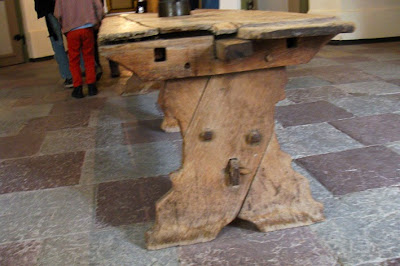The Luneburger kloster contain an enormous amount of medieval furniture: hundreds of chests, cupboards and armoires, but also some interesting medieval tables. These are not like the trestle type table as found in the Onze Lieve Vrouwe ter Potterie in Bruges, although there are some similarities.
The medieval tables in Kloster Lune
In the winter refectory of the convent a 8.5 meter long oaken table is found. The table top is made from a single piece of wood with a thickness between 4 and 5 cm. The width of the table is around 50 cm, which makes the weight of the table top approximately 138 kg (half the weight of the trestle table of Bruges). It is believed that the table was also used as a working table for the embroiderers of the convent. The table has some unique features: beneath the table top are small lockers. The 'open spaces' are places where once doors were fitted. The remaining holes of the hinges can still be seen, as well as a remaining door. I did not check if the lockers were on both sides of the table, but the placements of the 'open spaces' make this a likely option.
The large medieval table with the row of lockers beneath the table top.
Image from the book 'Luneburger Einblicke' by C. George, A. Tamme and B. Ness.
The placement of the legs is irregular. Two are quite close to each other. This is exemplified by the number of the locker 'open spaces' between the table legs: 1, 3 and 4, respectively. The table legs are only connected to each other at the top by the locker row.
The winter refectory with the large medieval table. You can see that two of the table legs are close to each other. At the right end of the refectory another medieval or/renaissance table can be seen. Image scanned from a postcard.

The summer refectory painted in the original colours. Some medieval/renaissance tables are standing here. More of these tables are in the convent, all with a table top of a single piece of wood (but less thick). The legs are connected to each other with a beam, fastened by a pegged mortise. Image scanned from a postcard.
The medieval table from Kloster Medingen
Kloster Medingen is a bit curious convent. The current building has been built after a fire destroyed the medieval convent in 1781. Despite the destruction of the medieval building (except the brewery), it is full of medieval furniture. How did it survive the fire? No one knows. Perhaps St. Mauritius (the patron saint of the convent) miraculously intervened. The convent has a special medieval table which is located in one of the large hallways. Normally, it is not allowed to take photos in the convent, but after the guide had seen us taking so many notes on the pieces of furniture, we got the special permission to take photos of this very special table.
The medieval click-on table of Kloster Medingen.The middle leg is different: smaller and not fixed by a peg to the lower beam.
You can best describe the medieval table as a click-on table, where extra tables can be added 'seamlessly'. The table top is made such that at the end one half is extended, and the other not, while at the same time the upper half of the extended part is removed, and the lower part of the un-extended part. A next table top with the opposite configuration can 'click' into the first table top. This can continue until a large table is produced. Unfortunately this is the only table, and we can not see the 'click' in action. At the end of the table are also two square holes, and I think these were used for a piece of wood to fasten two tables together.
View of one side of the table. The X-leg is fastened by dowels to the table top. The two parts of the X are connected by two dowels and the mortise and pen of the lower beam. The 'click-on' version of of the table top is clearly visible here.
The rest of the table construction is typical of a so-called cloister-table with X-legs and a supporting rail fastened by mortise and pen. These X-type cloister tables remained popular even until the last century. In fact I am adjusting such a modern cloister table to a have more medieval look. One thing, however, is different: the central leg of the Medingen table is no X type and much smaller than the outside X-legs. The Medingen table was measured by counting the floor tiles. One floor tile equalled 1.5 times of my foot (= 48 cm). The table had a length of 5.5 tiles (~264 cm) by 2 tiles (~96 cm).
Scheme of connecting two medieval 'click-on' tables.
Two of the blocks shown below could have been used to fasten the two tables.
The other end of the table. You can see the two gaps left and right of the leg that likely
were used to connect two tables. The 'click on' construction of the table top is reversed.
Two views of the underside of the table. You can see the top rail connected with a diagonal rail to the lower beam. The middle leg consists of one piece of wood and is much smaller than the outer X-legs.
Once a single piece of wood, the table top is now split in two. My notebook is lying on the table top.










No comments:
Post a Comment